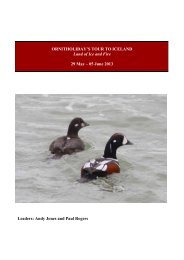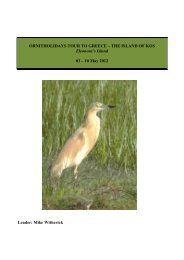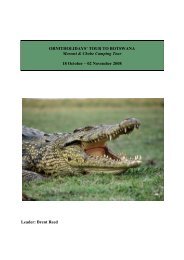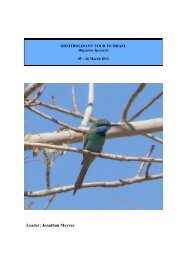Download 2014 Brochure (.pdf) - Ornitholidays
Download 2014 Brochure (.pdf) - Ornitholidays
Download 2014 Brochure (.pdf) - Ornitholidays
Create successful ePaper yourself
Turn your PDF publications into a flip-book with our unique Google optimized e-Paper software.
S PA I N<br />
Spain – The Canary Islands<br />
Winter Sunshine Break<br />
Saturday 15 February – Saturday 22 February <strong>2014</strong><br />
Leaders: David Walsh and Paul Rogers<br />
<strong>2014</strong> Cost: £1,999 single room supplement £120<br />
Sunday 14 February – Sunday 21 February 2015<br />
Principal Leader: David Walsh<br />
2015 Cost: £2,099 single room supplement £130<br />
La Palma<br />
La Gomera<br />
CANARY ISLANDS<br />
Lanzarote<br />
Fuerteventura<br />
Tenerife<br />
Gran Canaria<br />
T<br />
he Canary Islands provide us with the chance of seeing some special birds in welcome late winter sunshine! Remarkable for the wealth of unique<br />
plant and animal life, this Archipelago has been isolated from the continents for a long period, thus giving rise to an endemic avifauna not found<br />
in any other part of the world. The Canaries are made up of seven islands and five islets, which fall conveniently into two main groups – the Western<br />
Islands (Tenerife, Gomera, La Palma, El Hierro, Gran Canaria) and the Eastern Islands (Lanzarote, Fuerteventura and five islets). This natural division<br />
is based on the physical characteristics which the islands exhibit and we plan to visit three of them during our tour. Tenerife is the largest of the Canary<br />
Islands and its varied landscapes reflect its volcanic origins. Here, and on the adjacent island of La Gomera, the prevailing winds produce a climate<br />
conducive to ancient laurel forests and open pines. The eastern island of Fuerteventura is completely different and more like North Africa, being much<br />
drier with scrubby vegetation, rocky gorges and desert-like scenery. The Canary Islands hold a number of endemic (and near-endemic) species,<br />
including Fuerteventura Stonechat, Atlantic Canary, Blue Chaffinch and Bolle’s and Laurel Pigeons. In addition there is a healthy population of<br />
Houbara Bustard and we hope to see this species in its spectacular display alongside Cream-coloured Courser and Black-bellied Sandgrouse.<br />
Additionally, there is the chance to spot some interesting seabirds and cetaceans. The main tour leader will be David Walsh who has made more than<br />
10 winter visits to the Canary Islands.<br />
ITINERARY<br />
Mountain View on Tenerife<br />
Days 1 to 4<br />
We depart from London, or Manchester, to<br />
Tenerife. Depending on when we arrive, there<br />
may be time for some late afternoon birding.<br />
We check-in to our hotel on Tenerife where we<br />
stay for the next four nights. The wonderfully<br />
varied island of Tenerife is dominated by the<br />
volcanic Pico de Teide (3718m), the highest<br />
mountain in Spain. The north of the island is<br />
often cloudy and the hills have moist laurel<br />
forests. The central area consists of open pines<br />
and a high plateau, whilst the south is in the rain<br />
shadow and is drier and sunnier. On our first full<br />
day we will concentrate on the south and<br />
central areas. In the open pines, which occur<br />
above 800m, we will visit a well-known picnic<br />
site in search of the endemic Blue Chaffinch<br />
and we will hope to have excellent views of this<br />
species as well as the local races of Goldcrest,<br />
Great Spotted Woodpecker and African Blue<br />
Tit. We also have our first opportunity of seeing<br />
the Atlantic Canary, the symbol of the islands,<br />
renowned for its distinctive song. Weather<br />
permitting, we will venture higher and marvel at<br />
the spectacular volcanic, moon-like, rock<br />
formations in the centre of the island where the<br />
excellent display boards will prove informative.<br />
On the barren plains of southern Tenerife, with<br />
their prickly pears and euphorbias, we will have<br />
our first chance of seeing Berthelot’s Pipit and<br />
Plain Swift; these two species are restricted to<br />
the Canary Islands and Madeira. On some<br />
previous trips local information has also helped<br />
us locate a number of rarities, with American<br />
ducks and waders amongst the possibilities!<br />
The next day we will take the inter-island ferry to<br />
La Gomera. The boat trips will give us the<br />
opportunity of looking for Macaronesian and<br />
Cory’s Shearwaters, whilst we will also hope to<br />
spot groups of Shortfin Pilot Whales or Bottlenosed<br />
Dolphins. On arrival on Gomera we will<br />
head for the beautiful laurel forests and find<br />
good vantage points from where patient<br />
scanning should produce views of our main<br />
target species, the endemic Bolle’s and Laurel<br />
Pigeons. We will enjoy lunch at a restaurant in a<br />
100<br />
For a previous tour report or further information please call: 01794 519445








